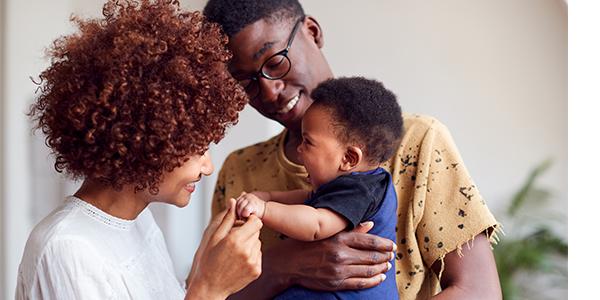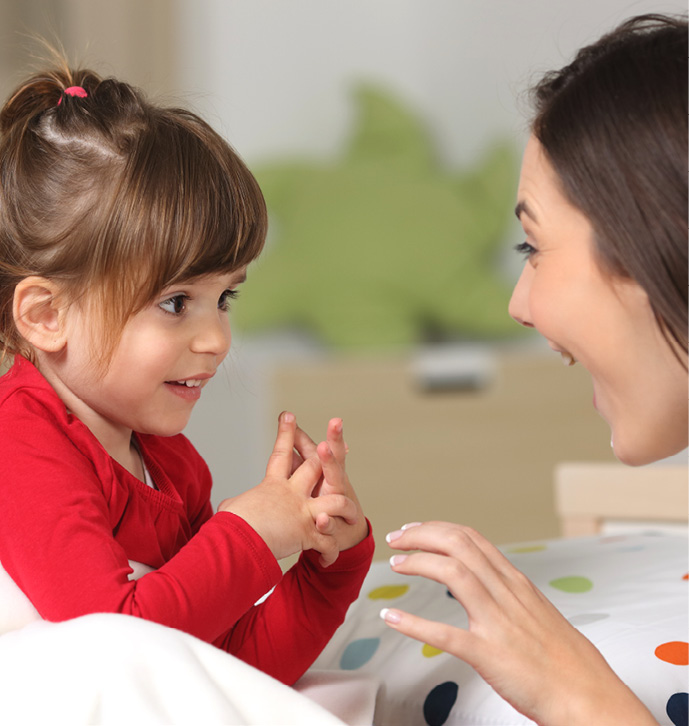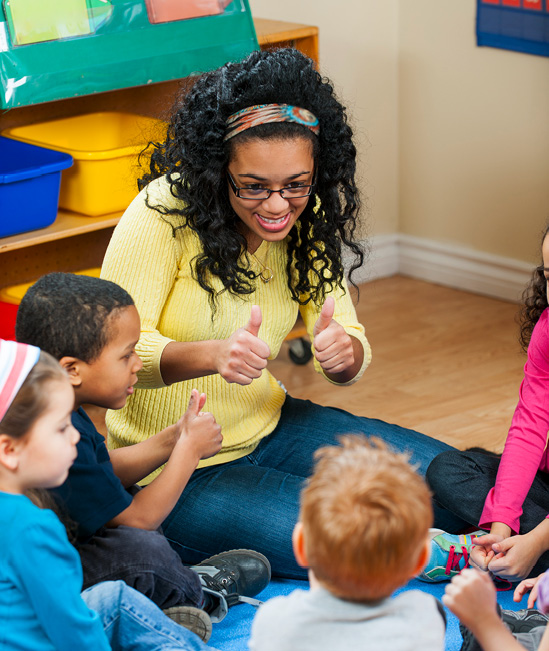Rocking and Rolling. Nurturing Infants and Toddlers with Diverse Language Experiences

You are here
Eight-month-old Anka is having trouble settling in to her second week at the child care center. Miriam, her care specialist, does not speak Gujarati (a language spoken in India), which is the language Anka is used to hearing at home. As Miriam tries singing some soothing songs in English to no avail, another child’s mother walks by and casually remarks, “It doesn’t matter what language you sing. She’s not even talking yet!” Miriam opens her phone and brings up a recording of Anka’s mother singing a traditional song and plays it while holding and rocking Anka. Miriam begins to sing along, imitating the words as she gets familiar with the tune. As Anka relaxes and starts to smile, Miriam feels confident that her efforts to support connections with Anka’s home language are making a difference.
We use the term dual language learner (DLL) to refer to any young child who is learning two or more languages. Many experts believe that growing up bilingual is beneficial for both children who are DLLs and for all children in general (Zero to Three 2016). But the most important considerations in the infant/toddler room focus on the here and now: what will help this baby feel safe and secure here? How can we best help each child comprehend what’s happening around them? It is also important to honor the rich language and cultural traditions in each child’s family so that every infant and toddler can feel a sense of belonging.
Recent research has provided a lot more information about the ways infants and toddlers experience two or more languages. When it comes to processing speech sounds and language, infant brains are surprisingly sophisticated (see https://bit.ly/2TmyMH5 for additional insights). Babies can detect the sounds of one or more familiar languages from birth (May et al. 2011). Most will understand a large number of words long before they can talk, and they use the language they hear to help organize the concepts they are learning (Vouloumanos & Waxman 2014).
It is important to support all languages in an infant or toddler’s life to build relationships with them and help them learn. Even if you are not fluent in a child’s home language, there are many ways to provide linguistically responsive supports. It’s helpful to partner with families from the moment they enroll in a program. Miriam’s strategy in the opening vignette of learning songs from Anka’s family is a great way to start. Here are some additional tips.
When you speak a child’s home language
- Be an excellent home language model when interacting with infants and toddlers. Use full, correct sentences and read or tell whole stories—even brief ones—in the home language.
- Choose songs and rhymes that use real words in the home language to make it easy for a child to use the words and to learn those same words in English later on. For example, you can sing a song about washing hands or playing with a ball that has words and actions children use or do every day. A song with silly, made-up words like “willowby, wallowby, woo” might be fun, but it doesn’t add any meaningful words to your interactions with the children, and those nonsense words can’t be translated in a new language.
- Follow each child’s interests to build on prior knowledge they have learned in their home language. Make connections with the cultural traditions, foods, and materials of the child’s family as well as the vocabulary.
When you don’t speak a child’s home language
- Ask family members to teach you key words in their home language that they frequently use to communicate with their child.
- Learn to say the names of children’s family members, pets, and favorite items the way they are said at home and use them to talk about family pictures with the child.
- Record the child’s babbling and speech attempts and ask family members to help you notice sounds that are meaningful in the home language so you can respond appropriately. For example, you might discover that a child from a Moroccan Arabic-speaking family frequently says, “Pappa! Pappa!” An English speaker might think the baby is asking for their father, but darija is an early word for bread in Moroccan Arabic. Once the teacher knows this, he can pull out a book with pictures of bread, play with the child in the kitchen area, or provide a snack.
- Speak your own language to a child, repeating the same sentence patterns often and using props, pictures, and actions to help the child understand.
- Celebrate your accomplishments as you learn new languages along with the children and model a confident approach to developing bilingualism.
Incorporating additional language supports
Spending time in an environment where different languages are spoken can be very stimulating for young children. It is helpful to pay extra attention to some practices and environmental details to ensure effective supports for all children.
Eye contact is one important factor in supporting language development. As infants process the language they are hearing, they need to watch adults’ faces, so be sure to have individual face-to-face time with each child every day. Be mindful of background noises that might interfere with children’s ability to clearly hear adult speech. Update the play and learning materials available to children to help them make active learning connections with the words you use while caring for and teaching them. Let your observations of children’s play guide your choices of what materials to add or put away.
The way we approach supports for children who are DLLs is unique in the first three years of life. We focus as much on meeting a child’s social and emotional needs as we do on helping them learn words and concepts. The strategies you choose should support children and engage their curiosity without causing too much demand or stress. If children respond best to their home language, there really is no rush to expose them to English for at least the first 12 to 18 months. The new language can be added gradually in fun, responsive, and low-stress ways throughout children’s second and third years. Research has shown that a strong foundation in the home language helps children succeed in learning English later on. Home language interactions do not confuse young children or interfere with their later learning of English (National Center on Cultural and Linguistic Responsiveness, n.d.). For even more strategies you can incorporate in the classroom, visit Teaching at the Beginning’s YouTube channel for free videos.

Think about it
- How do you feel about learning words in a new language? What are some strategies you could use to take small steps to build your confidence?
- In some ways, the care you provide for all infants and toddlers will be the same regardless of the languages spoken by their families. In other ways, language differences may make you aware of questions or challenges in your work. What are some of the questions or challenges you think of when working with linguistically diverse young children?
- How have you partnered with each child’s family to help them more successfully support their child’s home language at home? How have you partnered with each child’s family to help support the child’s home language in your setting?
Try it . . . with the home language
- Choose or create a book for each child with pictures that are interesting and familiar to him or her. Either purchase the book in a home language version for each child or add labels with home language words, if needed. Keep one copy in the center and send another copy home so families can extend the child’s learning using their home language.
- Talk about the objects and actions the child sees in the book. Remember: it is easy to label things, but children also need to learn verbs, adjectives, and feelings words in order to communicate.
- Provide additional opportunities to actively practice the vocabulary in the book. Try using puppets, gestures, or props that enable you and the child to imitate what’s in the book and practice the words together in the context of play.
Try it . . . with English
- Choose or make a book with photos (which are more easily understood than drawings). Look for repeating lines or sentence structures, such as “Brown bear, brown bear, what do you see?,” to help the child understand and retain the words.
- Send a copy of the book home to the family with the words in their home language. If the family members read or describe the book to the child in the home language, they will build a foundation of understanding about the content that will help the child learn English words when they are with you.
- Find opportunities to practice the same nouns, verbs, and complete sentences at different times or in different activities. For example, if a child shows an interest in playing with water, find a book with pictures and words about water and use the same words when he is playing at the water table or washing his hands at the sink.

Good partnerships with families can help support the learning of new languages for children and for teachers. Effective observation skills will enable you to notice and record what topics are most interesting to children and which language they respond to in different circumstances. What works best will depend on the teacher’s language skills as well as children’s experiences and interests. There is no one-size-fits-all approach to working with infants and toddlers who are DLLs. Getting to know the family and responding to each child individually will help you nurture their blossoming language skills.
References
May, L., K. Byers-Heinlein, J. Gervain, & J.F. Werker. 2011. “Language and the Newborn Brain: Does Prenatal Language Experience Shape the Neonate Neural Response to Speech?” Frontiers in Psychology 2: (222). www.frontiersin.org/articles/10.3389/fpsyg.2011.00222/full.
National Center on Cultural and Linguistic Responsiveness. N.d. The Benefits of Being Bilingual. Grant document prepared for the US Department of Health and Human Services, Administration for Children and Families, Office of Head Start (Grant No. 90HC0001). Washington, DC: Head Start Early Childhood Learning & Knowledge Center. https://eclkc.ohs.acf.hhs.gov/sites/default/files/pdf/benefits-of-being-bilingual.pdf.
Vouloumanos, A., & S.R. Waxman. 2014. “Listen Up! Speech Is for Thinking during Infancy.” Trends in Cognitive Sciences 18 (12): 642–46.
Zero to Three. 2016. “Dual Language Development: Double the Benefit.” American Baby. www.zerotothree.org/resources/303-dual-language-development-double-the-benefit.
Photographs: © Getty Images
Karen Nemeth, EdM, is an author and speaker on early childhood language development. She is the senior training and technical assistance specialist–DLLs for the National Center on Early Childhood Development, Teaching, and Learning at ZERO TO THREE. She is the author of Basics of Supporting Dual Language Learners: An Introduction for Educators of Children From Birth through Age 8. [email protected]